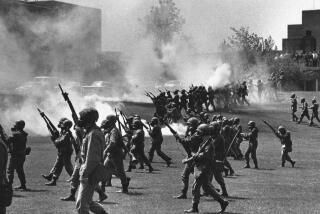Mystery Haunts a Civil War Story
NO CERTAIN REST
A Novel
By Jim Lehrer
Random House
226 pages, $23.95
âBattles such as the one fought on this ground are never really over. The force of the collision and the rawness of the death and the loudness of the screams preclude certain rest.â So ruminates retired U.S. Army Col. Gary Wayne Doleman in view of the banks of Antietam Creek, 135 years after the carnage that took place there. The fictional colonelâs words not only provide an apt title for the disturbing, engrossing novel through which he ambles as a sort of Virgilian guide to that hellish Civil War battlefield--they also presage modern-day embroilments.
Judged by its cover, âNo Certain Restâ bears all the earmarks of a handy beach-blanket mystery, embellished with sufficient Civil War facticity and pedagogy to attract the not inconsiderable book-buying population of buffs.
Read from the inside, however, Jim Lehrerâs re-visitation of the morning of Sept. 17, 1862, is the chronicle of a haunting. In his concluding notes, the prolific and multifaceted author (yes, that Jim Lehrer, who apart from other accomplishments numbers 12 novels to his name) implies that he struggled to finish the writing of this story. In fact, he says, without the encouragement of people close to him, especially his wife, âthis novel would never have seen the light of day.â
One might seek an underlying reason for such authorial reluctance in light of passages like this one: â[I]n an excerpt from a Hartford-published pamphlet ... Don found an account of the death of Lieutenant Allbritten.... Don saw long streams of red blood and hunks and pieces of hair and skin and blue uniform and skull and brains splatter to the winds. Then he saw the bloody stump of a manâs neck as the rest of his headless body fell to the ground.â
Lehrer would not be the first writer to be so shaken by the grisly nature of his material that he can hardly set it down on the page. And what exerts the opposing fascination? Surely it is that, as the colonel tells his younger, civilian friend Don, â âThis is the place to be astonished that all of these young men, on both sides, so willingly gave their lives.... It is a wonder-- an astonishment--there was not more running the other way, that honor so ruled this battlefield.â â The event that rejoins the two men on a spring day in 1998 at Antietam Creek is the very recent discovery there, by Civil War relic hunters, of human bones. The remains of a Union officer, no less. And despite those afore-cited accounts of Lt. Allbrittenâs having been blown to high heaven, Don finds evidence leading him to suspect that this intact corpse, apparently executed by a pistol shot to the head, might be that of the hero of the Connecticut Eleventh.
Fortunately, Don--respectfully addressed by colleagues as Dr. Don Spaniel--has an unusual job, a dream job from the point of view of the Civil War-obsessed: He is an archeologist in the employ of the National Park Service, a sort of âskinny guy in glasses,â Indiana Jones to the buried secrets of the War Between the States. Heâs single (âIâm accused of living too much in the pastâ), skilled at maneuvering within bureaucratic budget limits, and has the team and tools at his command to solve the mystery of this murdered Union soldier.
As a mystery novel, âNo Certain Restâ has certain problems. Not least of these is the classic pitfall of an overly visible solution--visible, that is, to all but the questing protagonist. In this case, by page 85 the outlines of motive, weapon, perpetrator and stratagem have been pretty well disinterred, but Donâs eureka moment doesnât occur until a good 50 pages later.
Nor do the personal conflicts of the detectiveâs life take up the slack in suspense, for Don has no personal life, no girl (nor much desire for one), no friends but the distant, and dying, colonel. (One wonders why Don Spaniel bears such an unprepossessing last name, in contrast to the manly sounding Allbritten. One wonders at an academic PhDâs being routinely called âdoctor,â without demurring.)
Finally, the writing style in the present-day passages can be as stiff and flat--âDonâs brain quickly got cramped, and his hand got cramped from note takingâ--as a Park Service memo.
However, the heart of âNo Certain Restâ isnât Donâs surface story. A good part of the book, its most riveting passages, are presented as excerpts from memoirs written by Union soldiers and veterans.
These first-person voices are consistently compelling. They paint vivid tableaux; they shine with the truthfulness, hard-held values and modesty of an unrecoverable age.
It comes then as no great surprise to learn from Lehrerâs notes that âthe words ... to describe the horror on the battlefield are taken directly from real soldiersâ first-person accounts in letters.â These accounts of doubt and valor lead us straight to the real riddle for our more cynical time, the same mystery that consumed Col. Doleman--Why did so many young men, especially from the relatively unthreatened North, volunteer to risk death?
There is surely no single, simple answer.
But one motive seemed to dominate all others, namely, the value of preserving the ideal of the Union, and the yet-unfulfilled destiny of these United States. Those boys marched into battle believing, as their commander in chief exhorted, that âa house divided against itself cannot stand.â
More to Read
Sign up for our Book Club newsletter
Get the latest news, events and more from the Los Angeles Times Book Club, and help us get L.A. reading and talking.
You may occasionally receive promotional content from the Los Angeles Times.







